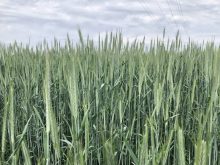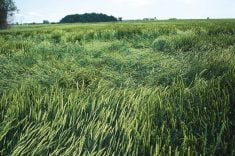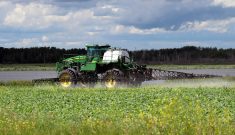Where there’s enough moisture and high fertility levels, lodging can still be a major yield constraint. In cereal crops, plant growth regulators (PGRs) have been shown to produce shorter stems to reduce lodging and maintain grain yields. Researchers in Alberta are trying to optimize PGR use to prevent lodging and improve standability and harvestability in high-yield environments.
How do PGRs work?
PGRs are applied to the crop foliage. PGRs change plant physiology by reducing cell elongation, reducing stem length and shortening the uppermost internodes and peduncle. They may also alter stem diameter.
Read Also

Cancer agency reclassifies another herbicide ‘probably carcinogenic’
The WHO’s cancer research agency has now put atrazine, a herbicide well known to corn growers, in the same potential-hazard category where the agency put glyphosate.
There are two types of PGRs available in Western Canada. The first are ethylene-releasing agents, such as Ethrel from Bayer CropScience, which has the active ingredient ethephon. Ethrel is registered for use on wheat, and when applied at the correct growth stage — GS 37 (flag leaf still rolled) to GS 45 (late boot stage) — it decreases plant height and increases stem wall thickness but may also increase tillering.
The second type of available PGRs are gibberellin inhibitors. Gibberellins (GA) are plant hormones that regulate cell elongation and a number of other developmental processes. Gibberellin inhibitors reduce stem elongation, shorten the crop and reduce lodging. In Western Canada, Manipulator (with the active ingredient chlormequat chloride) was recently registered for use on wheat by Belchim Crop Protection Canada (formerly known as Engage Agro Corportion).
Syngenta is in the process of registering a new product with the active ingredient trinexapac-ethyl. Trinexapac-ethyl is registered in many countries around the world, but not currently approved for use in Western Canada.
Evaluating PGRs
Since 2014, Sheri Strydhorst of Alberta Agriculture and Forestry, Dr. Linda Hall of the University of Alberta and Laurel Thompson of Lakeland College have been evaluating the effect of PGRs on Canadian Prairie Spring Red wheat, Canadian Western Red Spring wheat, malt barley, feed barley, oats and field peas. (Although currently PGRs are only registered for wheat in Canada.)
Their evaluations have focused on two products: Manipulator and trinexapac-ethyl (TXP) that have been shown in previous research to reduce height and lodging. Both products have a slightly different mode of action and work to obstruct different stages of GA biosynthesis, so they’re expected to produce different physiological responses, says Strydhorst.
Research results are variable because PGR performance depends on crop species and variety. “Some PGRs work better on some crop species than others,” says Strydhorst. “For example, in response to chlormequat chloride (CCC, the active ingredient in Manipulator), wheat shows the largest height reductions, and barley has an intermediate response. However, barley is more responsive to TXP than CCC in terms of height reduction and improved standability.”
The researchers are also looking at various tank mixes using these products.
The researchers are also looking at various tank mixes using these products. Strydhorst says they are trying to tank mix these two active ingredients to improve the consistency of PGR responses. “However, we have not identified the ‘optimal’ tank mix amounts of these actives, nor are they registered for use in Western Canada,” she says. “Also, not all cultivars show similar height or lodging responses to PGRs.”
Application timing
Correct application timing is crucial for good results and to avoid crop damage. Ethrel should be applied when most of the tillers are between early flag leaf emergence to swollen-boot stage, and should not be applied after more than 10 per cent of the awns have emerged.
Alberta research has found the most effective application time for consistent height reductions with Manipulator is between the beginning of stem elongation, when the first internode begins to elongate and the top of the inflorescence is at least one centimetre above the tillering node, to the time when the second node is at least two centimeters above node one.
“The research also suggests that the ideal staging for trinexapac-ethyl on wheat is similar to Manipulator, but additional research is required for both Manipulator and trinexapac-ethyl to identify the option of co-application with fungicides,” says Strydhorst.
Research results
Strydhorst and her colleagues have seen negligible effects of PGRs on yield. “PGRs can positively or negatively affect yield, but results are inconsistent depending on crop lodging, environmental conditions, crop species and cultivar,” she says. Strydhorst also says preventing lodging leads to other quality and production benefits.
Lodging can reduce yields from seven to 35 per cent with the greatest yield reductions occurring when lodging happens within 20 days after anthesis. The magnitude of yield loss to lodging depends on several factors: variety susceptibility to lodging; growth stage and severity of lodging; wind and rain events; or early snowfall. Later lodging, during ripening, can increase sprouting, increase the need for grain drying and lowering grades. Lodging can also cause costly harvesting delays.
“Increased amounts of lodging can be seen where there are insect or disease infections, increased fertilization and higher seeding rates,” says Strydhorst. “By preventing lodging we can prevent these yield and quality reductions, and the improved standability helps speed harvest times.”
On occasion they have also seen a reduction in protein levels with PGRs. “The protein content of AC Foremost wheat not receiving a PGR was 12.5 per cent, with Manipulator 12.4 per cent and with trinexapac-ethyl 12.5 per cent,” says Strydhorst. “The significantly lower protein content of Manipulator-treated wheat could be concerning when protein levels are near the minimum requirements. However, our small-plot research trials found that when either PGR was used in combination with a foliar fungicide application, AC Foremost protein reductions were avoided.”
Do you need a PGR?
Growers in a high-yield environment, with high fertility and with a history of lodging issues should consider a PGR, says Strydhorst. They should also consider the variety. “For example, in a high-yielding environment, AAC Brandon will lodge more readily than AAC Penhold which has improved genetic resistance to lodging,” she says. “PGRs should not be used under conditions of heat or drought stress as they often reduce yield. In these conditions, lodging is not likely a concern and Mother Nature acts as your PGR.”
Many wheat varieties inWwestern Canada have good (G) or very good (VG) lodging resistance built in, so why use a PGR? “These G or VG lodging resistance ratings are simply not sufficient to keep high yielding wheat crops standing in environments with abundant moisture and high levels of fertility,” says Strydhorst. “Additional agronomic tools are still needed in these intensified production environments even on wheat varieties rated as G or VG for lodging resistance.”
There is some evidence that, because PGRs disrupt plant hormones, there can be some secondary effects such as delayed senescence (aging in plants), increased resistance to environmental stress or increased root growth. “PGRs are systemic but non-residual, which can result in undesirable side effects such as stem elongation in some varieties and temporary, short term height reduction,” says Strydhorst. “PGRs can also alter tiller growth. Both Manipulator and Ethrel can increase tiller growth, which may increase or decrease yield. Altered tillering may be attributed to changes in photoassimilate and nutrient availability or PGR-induced changes in plant hormonal patterns. The most noticeable side effect we have observed in our small plot research trials is delayed maturity.”
When environmental conditions are prime for lodging, they’re also ideal for disease pressure. If conditions warrant a fungicide application, they likely warrant a PGR too. “In some instances, we have observed that when a PGR was used in combination with a foliar fungicide application, protein reductions were avoided,” says Strydhorst.
The economics of PGRs
After some limited economic analysis, Strydhorst has shown the cost of a seven per cent yield loss (due to lodging) on a 65 bushel/acre CWRS wheat crop to be around $29.35/acre, a 15 per cent loss to be $62.89/acre and a 30 per cent loss to be $146.75/acre based on $6.45/bu. wheat prices. She doesn’t have any information on the direct economic value of a PGR as no yield increase is expected, and the benefits from a faster harvest are hard to quantify. “I think growers need to look at PGRs as a risk management investment.” She says. “If they can prevent or reduce lodging, harvest will be better and faster.”
PGRs are not a fit for every acre in Western Canada but they are certainly an option for use in high yield environments where there is a history of lodging.
















